#earth observatory
Text
Panoramic Tower
Observatory
Curitiba - Brazil 🇧🇷
#brasil#brazil#curitiba#curitiba city#tower panoramic#panoramic tower#earth observatory#observatory#rafael greca
111 notes
·
View notes
Text
A solar eclipse as seen from space (credit: NASA Earth Observatory/Joshua Stevens)
64 notes
·
View notes
Text
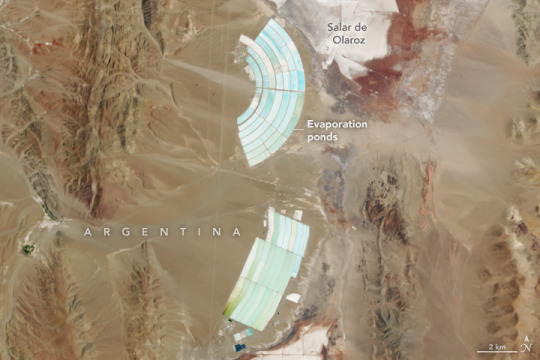
Mining Lithium in Argentina
Some of the largest known deposits of lithium—a soft silvery metal that powers batteries in cell phones, laptops, and electric vehicles—lie in one of the driest places on Earth. Much of the surveyed deposits of this metal are located in the arid salt flats of South America, where Chile, Argentina, and Bolivia meet.
The Altiplano-Puna Plateau is an elevated 500,000-square-kilometer area in the Central Andes, and the second highest plateau on Earth after the Tibetan Plateau. Several climatic and geologic factors converged in these dry plains to create large underground lithium deposits.
The Altiplano-Puna sits on one of Earth’s largest known reservoirs of active magma. Although the area receives very little precipitation (less than 30 centimeters [12 inches] a year), hydrothermal fluids associated with this volcanic activity naturally replenish underground aquifers. Over time, rocks containing trace quantities of lithium have weathered causing the metal to build up in the aquifers. According to the U.S. Geological Survey, about half of the world’s measured lithium resources are in these underground deposits in Bolivia, Argentina, and Chile, an area known as the “lithium triangle.”
The image above, acquired by the OLI (Operational Land Imager) on Landsat 8, shows lithium mines in northwestern Argentina’s Jujuy province, near the country’s border with Chile. The light blue evaporation ponds of the mines stand out. The mines are located just south of a large salt flat, known as the Salar de Olaroz.
To harvest the lithium, wells are tapped into the lithium-rich brine beneath the surface. They shunt the brine toward rectangular evaporation ponds lined with plastic. Once there, the briny mixture stays in the ponds for months at a time, where sunshine and wind separate out lithium, salt, and other substances through evaporation. This lithium-rich solution is then processed into lithium carbonate or lithium hydroxide.
Landsat images show the mine immediately adjacent to Salar de Olaroz has expanded several times since 2016, and it is now one of the largest lithium mines in Argentina. In 2018, evaporation ponds were developed for another mine 2 kilometers to the south. Global production of lithium has increased almost ten-fold over the last two decades, from approximately 15,000 metric tons in 2001 to 146,000 metric tons in 2022.
NASA Earth Observatory image by Wanmei Liang, using Landsat data from the U.S. Geological Survey. Story by Emily Cassidy.
9 notes
·
View notes
Text
Dirges of the Damned
V
We were not taught to understand our thought
We are prone to identifying with feelings
As if we possess every cloud that drifts by
Sometimes it is hard to take a good look
Without picking up the object
Rotating it in our hands
Moving it into better light
Sometimes it is hard to take a good look
When our eyes are pressed to the object
When our hands clutch it too tight
#dirges#dirges of the damned#original poem#original poetry#orignal writing#poem#poetscommunity#poetry#poems on tumblr#poems and poetry#poets on tumblr#writers and poets#poems#philosophy#thoughts#personal observations#earth observatory#spilled thoughts#mental illness#mental health
2 notes
·
View notes
Text

Source:
The setting Sun illuminates the western faces of sand dunes across this low-lying basin in northwestern China.
Image of the Day for February 18, 2024
Instrument:ISS — Digital Camera
1 note
·
View note
Text
Observatory exploration
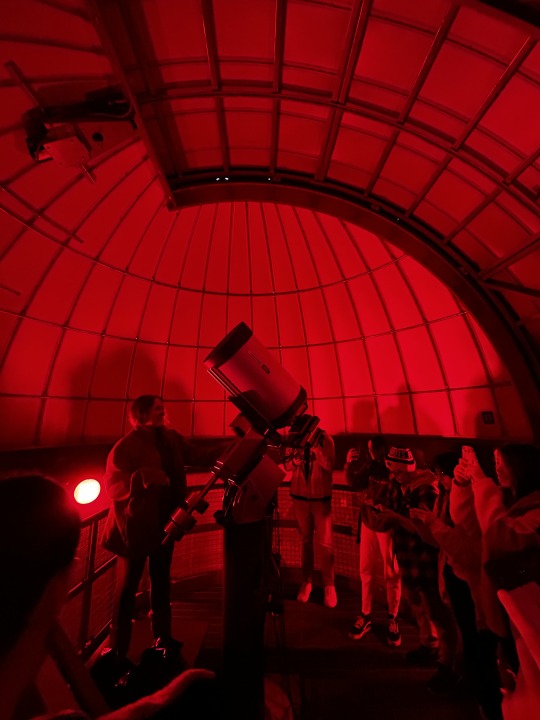
For the first time this week, I was lucky enough to step foot inside an observatory. This experience was quite unreal to me due to me having no prior knowledge to what an observatory carried. Being apart of this experience has taught me a lot of things about the observatory and what they exactly are capable of. While in the observatory we learned that the dome has the ability to rotate and the microscope can be adjusted manually. Another thing that caught me off guard regarding the observatory is just how small the telescope within the middle is. Despite being deceivingly little, the telescope shown here has the power to study objects that are 4.5 billion light years away(Quasar 3C66a). This camera also has the options to put different filters over the lenses to get different looking pictures from the same angle. An observation I noticed while in the observatory was that the whole room was illuminated with a red light. It made me curious as to why the room would need to be red in order to observe space. After researching I came to the conclusion that red-light has a peak wavelength of 635-700 nanometers, while normal light is 530. This makes it easier for the pictures to come out darker and get the color their looking for. Either way this experience was very interesting and made me want to learn a lot more about space and astrophotography. It also amazes me the amount of knowledge that Is required to capture these truly beautiful pictures.
1 note
·
View note
Text
Bottled Water Can Contain Hundreds of Thousands of Previously Uncounted Tiny Plastic Bits - Technology Org
New Post has been published on https://thedigitalinsider.com/bottled-water-can-contain-hundreds-of-thousands-of-previously-uncounted-tiny-plastic-bits-technology-org/
Bottled Water Can Contain Hundreds of Thousands of Previously Uncounted Tiny Plastic Bits - Technology Org
In recent years, there has been rising concern that tiny particles known as microplastics are showing up basically everywhere on Earth, from polar ice to soil, drinking water and food. Formed when plastics break down into progressively smaller bits, these particles are being consumed by humans and other creatures, with unknown potential health and ecosystem effects. One big focus of research is bottled water, which has been shown to contain tens of thousands of identifiable fragments in each container.
Image credit: Naixin Qian
Now, using newly refined technology, researchers have entered a whole new plastic world: the poorly known realm of nanoplastics, the spawn of microplastics that have broken down even further. For the first time, they counted and identified these minute particles in bottled water. They found that on average, a liter contained some 240,000 detectable plastic fragments—10 to 100 times greater than previous estimates, which were based mainly on larger sizes.
The study was just published in the journal Proceedings of the National Academy of Sciences.
Nanoplastics are so tiny that, unlike microplastics, they can pass through intestines and lungs directly into the bloodstream and travel from there to organs including the heart and brain. They can invade individual cells, and cross through the placenta to the bodies of unborn babies. Medical scientists are racing to study the possible effects on a wide variety of biological systems.
“Previously this was just a dark area, uncharted. Toxicity studies were just guessing what’s in there,” said study coauthor Beizhan Yan, an environmental chemist at Columbia Climate School’s Lamont-Doherty Earth Observatory. “This opens a window where we can look into a world that was not exposed to us before.”
Worldwide plastic production is approaching 400 million metric tons a year. More than 30 million tons are dumped yearly in water or on land, and many products made with plastics including synthetic textiles shed particles while still in use. Unlike natural organic matter, most plastics do not break down into relatively benign substances; they simply divide and redivide into smaller and smaller particles of the same chemical composition. Beyond single molecules, there is no theoretical limit to how small they can get.
Microplastics are defined as fragments ranging from 5 millimeters (less than a quarter inch) down to 1 micrometer, which is 1 millionth of a meter, or 1/25,000th of an inch. (A human hair is about 70 micrometers across.) Nanoplastics, which are particles below 1 micrometer, are measured in billionths of a meter.
Plastics in bottled water became a public issue largely after a 2018 study detected an average of 325 particles per liter; later studies multiplied that number many times over. Scientists suspected there were even more than they had yet counted, but good estimates stopped at sizes below 1 micrometer—the boundary of the nano world.
A tiny particle of polystyrene plastic as imaged by a new microscopic technique. It is about 200 nanometers across, or 200 billionths of a meter. Image credit: Naixin Qian
“People developed methods to see nano particles, but they didn’t know what they were looking at,” said the new study’s lead author, Naixin Qian, a Columbia graduate student in chemistry. She noted that previous studies could provide bulk estimates of nano mass, but for the most part could not count individual particles, nor identify which were plastics or something else.
The new study uses a technique called stimulated Raman scattering microscopy, which was co-invented by study coauthor Wei Min, a Columbia biophysicist. This involves probing samples with two simultaneous lasers that are tuned to make specific molecules resonate. Targeting seven common plastics, the researchers created a data-driven algorithm to interpret the results. “It is one thing to detect, but another to know what you are detecting,” said Min.
The researchers tested three popular brands of bottled water sold in the United States (they declined to name which ones), analyzing plastic particles down to just 100 nanometers in size. They spotted 110,000 to 370,000 plastic fragment in each liter, 90% of which were nanoplastics; the rest were microplastics. They also determined which of the seven specific plastics they were, and charted their shapes—qualities that could be valuable in biomedical research.
One common one was polyethylene terephthalate or PET. This was not surprising, since that is what many water bottles are made of. (It is also used for bottled sodas, sports drinks and products such as ketchup and mayonnaise.) It probably gets into the water as bits slough off when the bottle is squeezed or gets exposed to heat. One recent study suggests that many particles enter the water when you repeatedly open or close the cap, and tiny bits abrade.
However, PET was outnumbered by polyamide, a type of nylon. Ironically, said Beizhan Yan, that probably comes from plastic filters used to supposedly purify the water before it is bottled. Other common plastics the researchers found: polystyrene, polyvinyl chloride and polymethyl methacrylate, all used in various industrial processes.
A somewhat disturbing thought: the seven plastic types the researchers searched for accounted for only about 10% of all the nanoparticles they found in samples; they have no idea what the rest are. If they are all nanoplastics, that means they could number in the tens of millions per liter. But they could be almost anything, “indicating the complicated particle composition inside the seemingly simple water sample,” the authors write. “The common existence of natural organic matter certainly requires prudent distinguishment.”
The researchers are now reaching beyond bottled water. “There is a huge world of nanoplastics to be studied,” said Min. He noted that by mass, nanoplastics comprise far less than microplastics, but “it’s not size that matters. It’s the numbers, because the smaller things are, the more easily they can get inside us.”
Among other things, the team plans to look at tap water, which also has been shown to contain microplastics, though far less than bottled water. Beizhan Yan is running a project to study microplastics and nanoplastics that end up in wastewater when people do laundry—by his count so far, millions per 10-pound load, coming off synthetic materials that comprise many items. (He and colleagues are designing filters to reduce the pollution from commercial and residential washing machines.) The team will soon identify particles in snow that British collaborators trekking by foot across western Antarctica are currently collecting. They also are collaborating with environmental health experts to measure nanoplastics in various human tissues and examine their developmental and neurologic effects.
“It is not totally unexpected to find so much of this stuff,” said Qian. “The idea is that the smaller things get, the more of them there are.”
Source: Columbia University
You can offer your link to a page which is relevant to the topic of this post.
#000#algorithm#Antarctica#Babies#bloodstream#Brain#Cells#chemical#chemistry#Chemistry & materials science news#climate#Composition#container#Dark#data#data-driven#drinking#drinking water#earth#Earth Observatory#effects#Environmental#Filters#Food#Health#heart#Heat#how#human#humans
0 notes
Text
Satellite Imaging Market by Offering, Application (Surveillance & Reconnaissance, Navigation, Environmental Conservation, Disaster Response), Sector (Government, Energy & Mining, Environment & Climate, Insurance), and Geography - Global Forecast to 2030
#Satellite Imaging Market#satellite imaging#satellite#aerospace#space technology#earth observatory#technology#innovation
0 notes
Text
Mysterious "Ghostly Skull" in The Sahara Desert Revealed
This is a fantastic "image of the day" on NASA's Earth Observatory website. It was released on 2nd November and shows A Ghostly Face in the Rock from space.
#ufosightingsfootage#ufo#ufosfootage#ufos#realufo#ufonews#aliens#alien#moon#ufostoday#nasa#earth Observatory#iss image#isslivetv#issearth
1 note
·
View note
Text
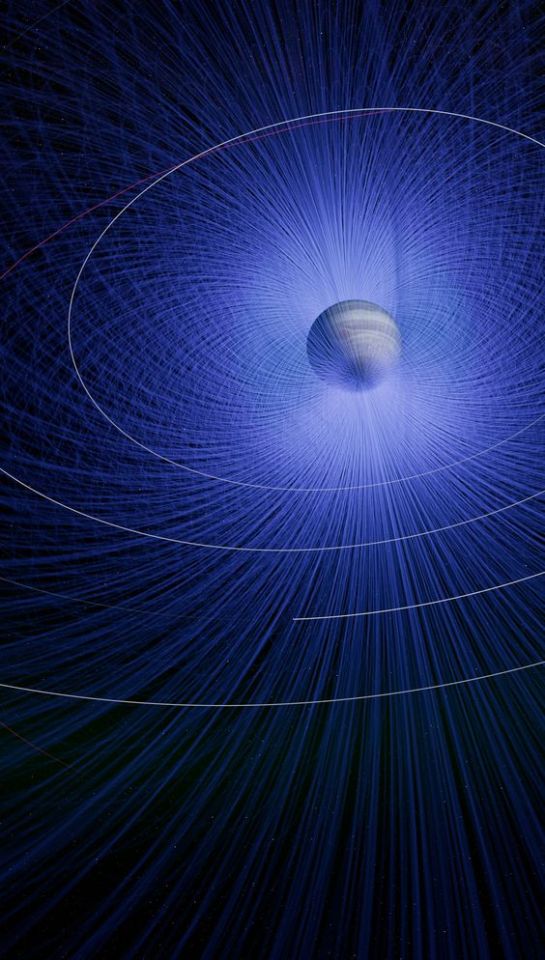
Explore Breathtaking 'World Beyond Earth' in Upcoming Planetarium Show
"The visuals that you see are all authentic artifacts of our exploration."
#artists on tumblr#photography#astrophotography#astronomy#astro notes#astro observations#astro community#astrophysics#astronomical observation#astronomical objects#astronomers#astronomical#world beyond Earth#planetarium#space#outer space#universe#galaxy#infinite worlds#observatories#science fiction
9 notes
·
View notes
Text

Looking Up and Down During the Eclipse
A total solar eclipse passed over parts of Mexico, the United States, and Canada on April 8, 2024. Millions of people witnessed skies darken as the Moon passed between Earth and the Sun, obscuring its bright light.
Astronauts aboard the International Space Station got a top-down view of the Moon’s shadow as it traversed North America. The image above, taken as the space station orbited above the North Atlantic, shows the eclipse’s dark shadow along with Earth’s bright horizon, or limb, at the boundary between the atmosphere and space. A crew ship docked to the space station is visible in the lower-left corner of the image.
The photograph below, also taken by an astronaut, captures the Moon’s shadow as it darkened portions of Quebec and New Brunswick in Canada and Maine in the United States. The gold-colored feature in the upper-right corner is part of a solar array on a resupply vehicle.

A total solar eclipse offers a unique opportunity to view and study the Sun’s active outer atmosphere, or corona. During totality, seen in the center of the composite photo below, the Moon perfectly blocks the bright face of the Sun, leaving the much dimmer solar corona visible. This composite was captured in Cleveland, Ohio, over the course of the approximately 2.5 hours it took for the Moon to move across the face of the Sun.

During totality, glowing loops of plasma called solar prominences could be seen extending into the corona. Plasma is super-hot ionized gas that flows along the tangled and twisted structure of the Sun’s magnetic fields. Some observers on the ground noticed spots of pink appearing within the corona’s light. The detailed photo below reveals that pink-tinged streamers were erupting into the corona.
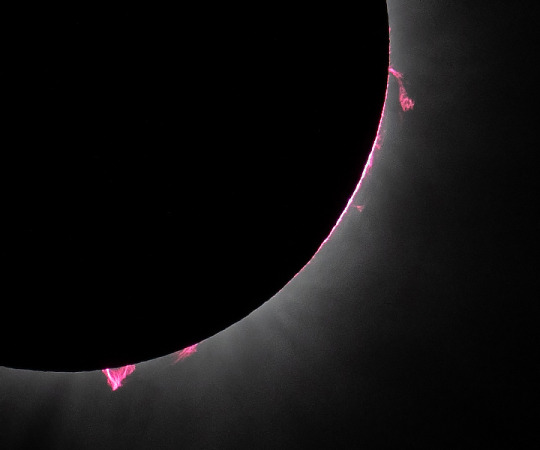
At the time of the eclipse, the Sun was near a solar maximum, a period of heightened activity that occurs about every 11 years when the Sun’s magnetic field flips. The Sun’s activity was much different during the 2017 total solar eclipse. At that time, it was nearing a solar minimum. As a result, the magnetic field was less tangled then and streamers were restricted to the Sun’s equatorial region.
Astronaut photographs ISS071-E-003390 and ISS071-E-002856 were acquired on April 8, 2024, with a Nikon Z 9 digital camera using 28 and 24 millimeter lenses, respectively, and are provided by the ISS Crew Earth Observations Facility and the Earth Science and Remote Sensing Unit, Johnson Space Center. The images were taken by members of the Expedition 71 crew. The images have been cropped and enhanced to improve contrast, and lens artifacts have been removed. The International Space Station Program supports the laboratory as part of the ISS National Lab to help astronauts take pictures of Earth that will be of the greatest value to scientists and the public, and to make those images freely available on the Internet. Additional images taken by astronauts and cosmonauts can be viewed at the NASA/JSC Gateway to Astronaut Photography of Earth. Photographs by NASA/Jordan Salkin and NASA/Keegan Barber. Story by Lindsey Doermann.
7 notes
·
View notes
Text
The solar eclipse from a million miles

This photo of the Moon's shadow taken from the NASA's Deep Space Climate Observatory orbiting at L1 shows the shadow of the Moon darkening North America.
Lagrange 1 is the neutral gravity point between the Earth and Sun, approximately one million miles closer to our star, way past the Moon - which means it can take images of the far side of our satellite, a perspective we can't get from Earth:

Primarily, though, it's a great position for monitoring the Sun, as the observatory can provide 15-60 minutes of advance warning before a solar storm (like a coronal mass ejection) batters Earth.
30 notes
·
View notes
Text

Earth-Sun eclipse, as seen by NASA’s Solar Dynamics Observatory (SDO) satellite in 2011. Launched in 2010, SDO continues to diligently monitor the sun to this day.
“Twice a year, SDO enters an eclipse season where the spacecraft slips behind Earth for up to 72 minutes a day. Unlike the crisp shadow one sees on the sun during a lunar eclipse, Earth's shadow has a variegated edge due to its atmosphere, which blocks the sun light to different degrees depending on its density. Also, light from brighter spots on the sun may make it through, which is why some solar features extend low into Earth's shadow.” - NASA
(©)
#nasa#space#spaceflight#science#engineering#spacecraft#technology#space exploration#aerospace#sun#solar#solar dynamics observatory#nasa sdo#eclipse#earth#satellite#astrophotography#solar system#star
89 notes
·
View notes
Text
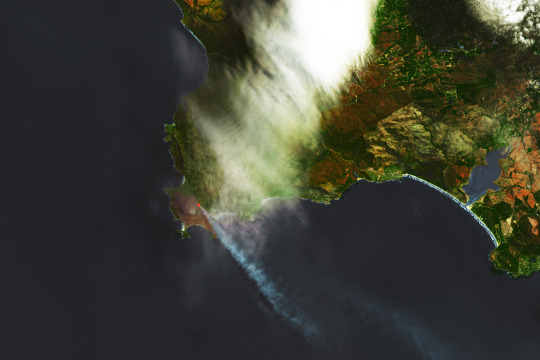
Hot, windy weather has fueled outbreaks of fire in South Africa’s Western Cape.
Image of the Day for February 3, 2024
Instrument: Landsat 8 — OLI
The infrared signature of the actively burning fire appears red.
If compared to wildfires.......


Hot, windy weather has fueled outbreaks of fire?!!!! This is super bad! Bad! What happens to climate change that even affects too much?! You want to know why I said this is too much when I saw this smoke(Not colour the smoke).


I do not agree with Drought because savannas are already designed to be strong in the desert(By nature) and this savanna was the reason that has fueled outbreaks of fire. I think it is because Human activity causes wind to hot and causes reactions strong winds quickly spread fires, making them difficult to control!
#land#fire#remote sensing#Fire Chars Pringle Bay#The South African Weather Agency#south africa#nasa#NASA Earth Observatory#earth observatory#analysis#wildland fire#satellite#map#Earth#climate#climate change#ocean
1 note
·
View note
Text

2 September 2022
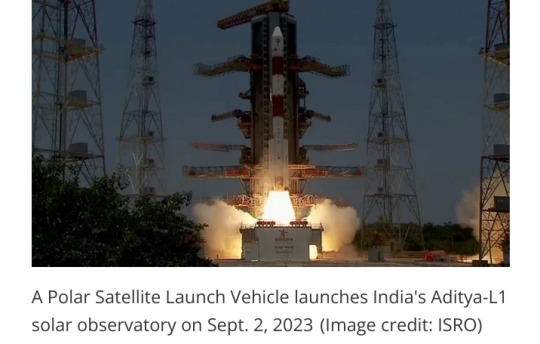
Fresh off its success at the moon, India is now headed for the sun.
The nation launched its first-ever solar observatory today (Sept. 2), sending the Aditya-L1 probe skyward atop a Polar Satellite Launch Vehicle (PSLV) from Satish Dhawan Space Centre at 2:20 a.m. EDT (0620 GMT; 11:50 a.m. local India time).
The PSLV deployed Aditya-L1 into low Earth orbit (LEO) as planned about 63 minutes after liftoff, sparking applause and high fives in mission control.
"Congratulations, India, and congratulations, ISRO [the Indian Space Research Organisation]," Jitendra Singh, India's Minister of State for Science and Technology, said shortly after deployment on ISRO's launch webcast.
"While the whole world watched this with bated breath, it is indeed a sunshine moment for India," Singh added.
The successful launch followed on the heels of another big milestone for India: On August 23, its Chandrayaan-3 mission became the first to land softly near the moon's south pole.
Chandrayaan-3's lander-rover duo are expected to conk out in a week or so, when the harsh lunar night falls at their touchdown site. But Aditya-L1's long journey has just begun.
A long road to a good sun-viewing spot
Aditya-L1 won't stay in LEO forever:
After a series of checkouts, it will use its onboard propulsion system to head toward Earth-sun Lagrange Point 1 (L1), a gravitationally stable spot about 1 million miles (1.5 million kilometers) from our planet in the direction of the sun.
That destination explains the latter part of the mission's name. And the first part is simple enough: "Aditya" translates to "sun" in Sanskrit.
The 3,260-pound (1,480 kilograms) observatory will arrive at L1 about four months from now, if all goes according to plan.
But the long trek will be worth it, according to the ISRO.
"A satellite placed in the halo orbit around the L1 point has the major advantage of continuously viewing the sun without any occultation/eclipses," ISRO officials wrote in an Aditya-L1 mission description.
"This will provide a greater advantage of observing the solar activities and its effect on space weather in real time."
Indeed, another sun-studying spacecraft is already at L1 — the Solar and Heliospheric Observatory (SOHO), a joint NASA-European Space Agency mission that launched in December 1995.
(Several other spacecraft, including NASA's James Webb Space Telescope, are at Earth-sun Lagrange Point 2, which is a million miles from Earth, in the direction away from the sun.)

Solar flares, the coronal heating mystery and more
Once it's settled in at L1, the solar probe will use four three science instruments to study the particles and magnetic fields in its immediate surroundings and four others to scrutinize the sun's surface (known as the photosphere) and its atmosphere.
This work will help scientists better understand solar activity, including the dynamics of solar flares and coronal mass ejections (CMEs), ISRO officials say.
Flares are powerful flashes of high-energy radiation, and CMEs are huge eruptions of solar plasma.
Both types of outburst can affect us here on Earth. Intense CMEs that hit our planet, for example, trigger geomagnetic storms that can disrupt satellite navigation and power grids.
(As a side benefit, such storms also supercharge the gorgeous light shows known as auroras.)
Aditya-L1 will also tackle the "coronal heating problem," one of the biggest mysteries in heliophysics.
The corona — the sun's wispy outer atmosphere — is incredibly hot, reaching temperatures around 2 million degrees Fahrenheit (1.1 million degrees Celsius), according to NASA.
That's about 200 times hotter than the solar surface, which is "only" 10,000 degrees F (5,500 degrees C) or so.
It's still unclear what is responsible for this startling and counterintuitive discrepancy.
(Why would it be hotter away from the sun's core, where the energy-producing nuclear fusion reactions are occurring?)
Aditya-L1 has other science goals as well. For instance, the mission also aims to more fully flesh out the solar wind, the stream of charged particles flowing constantly from the sun, ISRO officials said.
Aditya-L1 will measure the composition of the solar wind and attempt to determine how it is accelerated.
And Aditya-L1 will do all this work on the cheap:
The mission's price tag is about 3.8 billion rupees, or $46 million US at current exchange rates.
That's in the same ballpark as Chandrayaan-3
India's first successful moon-landing mission costs about 6.15 billion rupees, or $74 million US.
For comparison, NASA's most recent big-ticket sun mission, the record-setting Parker Solar Probe, costs roughly $1.5 billion.
This disparity should not be viewed as an indictment of NASA, however; labor costs are much higher in the United States than in India, among other differences between the two nations' economies.
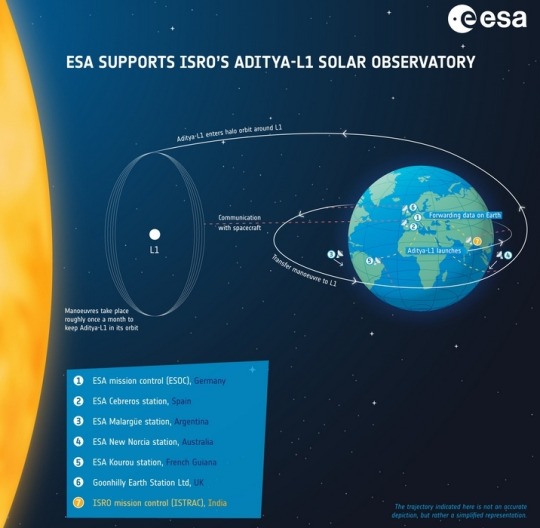
Aditya-L1 is a coronagraphy spacecraft to study the solar atmosphere, designed and developed by the Indian Space Research Organisation (ISRO) and various other Indian research institutes.
#India#Aditya-L1#Polar Satellite Launch Vehicle (PSLV)#Satish Dhawan Space Centre#low Earth orbit (LEO)#sun#Indian Space Research Organisation#Chandrayaan-3#Earth-sun Lagrange Point 1 (L1)#Solar and Heliospheric Observatory (SOHO)#solar flares#coronal mass ejections (CMEs)#coronal heating problem#heliophysics#solar wind#Parker Solar Probe#NASA#solar observatory#solar atmosphere
12 notes
·
View notes





